Guessing is closed because we welcomed Bailey’s calf on Wednesday, October 19 at 10:49 a.m.
The winner will be notified. Thank you for participating!
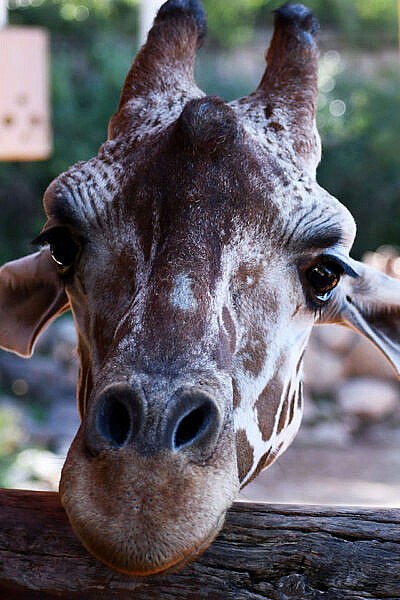

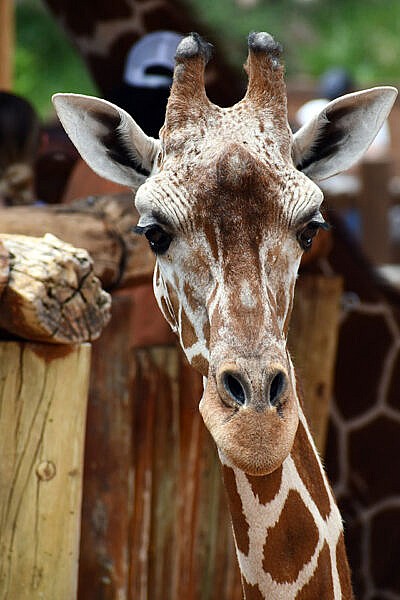


Bailey, a 10-year-old reticulated giraffe at Cheyenne Mountain Zoo, is expecting her second calf any day now. Anticipating the birth of a giraffe calf can be a roller coaster of emotions: excitement, wonder, impatience, nervousness and even worry.
Since establishing its giraffe breeding program in 1954, Cheyenne Mountain Zoo has welcomed 202 giraffe calves to the world. Through experiences with mothers and calves, the team has gained invaluable institutional knowledge that will guide them through Bailey’s pregnancy, labor and first moments as a second-time mom. Although every birth, calf and mother is unique, there are common milestones that help Bailey’s care team recognize whether things are on the right track.
Giraffe gestation, or length of pregnancy, isn’t an exact science. Giraffe pregnancies typically range between 14 and 16 months, which can make planning for the birth a bit of a guessing game. CMZoo’s breeding bull giraffe, Khalid, and Bailey last bred on July 19, 2021. That means Bailey’s due date window is Sept. 19 through Nov. 19, 2022.
“Most of us believe the baby will be born about mid-way through that window because Bailey had her last calf right around 15 months,” said Rachael Hahn, senior lead keeper in African Rift Valley. “My guess is September 30.”
Giraffe fans can submit their own guesses about when the calf will be born at cmzoo.org/guess. The person who guesses the closest day, time and minute Bailey gives birth will win a behind-the-scenes encounter with the CMZoo giraffe herd. (Visit cmzoo.org/guess for rules and details.)
Although the giraffe care team closely monitors Bailey’s pregnancy, labor and calf, their goal is to remain as hands-off as possible. They support Bailey through environmental changes that will best support mom and baby, like getting Bailey used to having her own room at night. The birth stall is in the same barn as the rest of the herd, separated by a fence. Bailey still gets the social interaction she enjoys from the herd and has space away from others to make her labor as calm and safe as possible. She shares the birth stall with Msichana, a 20-year-old female giraffe.
“We know we’re getting really close to labor when we see certain physical changes in Bailey,” said Hahn. “We will see changes in her udders. Typically, a few days before birth, the tips of a giraffe’s udders look waxy because colostrum is building up and starting to drip.”
During the day, Bailey will continue to join the herd in the main yard. If Bailey goes into labor in the main yard, as she did last time she had a baby, keepers are confident they’ll be able to move her into the birth stall, relying on the trusting relationship they have with Bailey. Giraffe labor has been known to last up to 10 hours, and typically the calf’s front hooves are the first part to emerge.
“We know our giraffe lovers start to worry when a giraffe is in labor for a long time, but we don’t have concerns unless we see a mother really struggling,” said Hahn. “It’s different for every giraffe, just like it is for every human. Bailey’s first labor lasted nearly four hours, and we didn’t see her struggle. She did lie down momentarily, but she stood back up just as soon as we asked her to.”
Another reason it’s best for Bailey to give birth in the separate stall is because the team brings in a special substrate – or floor covering. Giraffe regulars will notice the team is using a new kind of substrate this year, which has a red tint to it.

“The substrate helps cushion the baby’s fall when it is born,” said Hahn. “Giraffe calves fall about six feet to the ground when they’re born. It can seem like a jarring way to come into the world, but it’s important because the bump to the ground severs the umbilical cord and stimulates them to breathe. The substrate also helps absorb fluid so the calf and mom have better traction, which is especially important when the little one is attempting to stand for the first time.”
Once the calf is born, it can take a few hours for it to stand on its own. It’s normal to see mothers nudging calves with their feet and noses, encouraging the calf to stand. Learning to use those long legs for the first time is no easy task – especially when you’re only a few hours old.
“We expect to see a calf tumble and stumble, but as long as they’re trying, we’re happy,” said Hahn. “It can be a hard thing to watch if you’ve never seen it before, but it’s totally normal for mom to nudge them and for the calf to take a lot of spills before finally standing up.”
After standing, it’s usually time to eat. The giraffe care team likes to see a newborn calf nursing from mom within the first several hours. They watch closely for that important first meal of colostrum, which contains antibodies that give the baby a boost. In case the baby doesn’t nurse, the team has bottles and formula on standby.
CMZoo houses a Giraffe Plasma Bank for newborn calf emergencies, so this baby would also have immediate access to that treatment. The potentially life-saving plasma has been donated voluntarily by other members of the herd, and has been proven to help struggling newborn calves in the past.
The following few days and weeks, the calf and Bailey will continue to bond moving in and out new spaces both inside and outside as well as meeting new members of the herd. Keepers will watch Bailey and the calf’s behaviors to help determine when those big adventures occur.
“Ideally, Bailey takes the lead on raising the calf and staff will only intervene if it’s medically necessary,” said Hahn. “Bailey did an amazing job with her first calf, BB, and we’re cautiously optimistic that she and her new calf will be successful together, too. Of course, we’re ready to support them as much as we can if they do need our help.”
When Bailey goes into labor, Cheyenne Mountain Zoo plans to share the birth of her calf on its social media channels. Fans can check in on Bailey in her overnight birth stall, and see the herd outside during the day, at cmzoo.org/giraffecam or on the Zoo’s YouTube channel at youtube.com/cmzoocs.
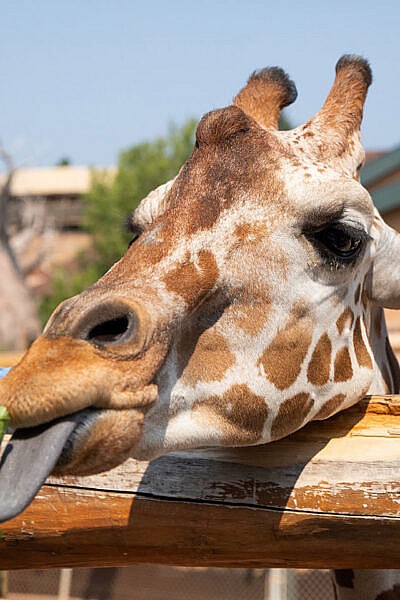

BAILEY’S DUE DATE IS BETWEEN SEPT. 19 AND NOV. 19, 2022 – On Wednesday, Sept. 14, Cheyenne Mountain Zoo shared an ultrasound video on its social media channels and asked fans to guess who at the Zoo was expecting a baby. This just in: it’s Bailey, a reticulated giraffe!
The calf would be the second offspring for mom, Bailey, and the seventh to be sired by dad, Khalid (pronounced cull-EED). Bailey and Khalid bred together on July 19, 2021. A healthy giraffe gestation can last from 14 to 16 months. Bailey’s last pregnancy was one day shy of 15 months (457 days) long. If she has another 15-month pregnancy, this baby would be born on October 19, 2022, but it could come as early as September 19, 2022 or as late as November 19, 2022 – and of course, any date in between.
This calf would be the seventeenth member of Cheyenne Mountain Zoo’s reticulated giraffe herd. Bailey moved to Cheyenne Mountain Zoo on a breeding recommendation in Sept. 2016. Bailey and Khalid welcomed their first calf, BB, to the world in September 2020, and BB moved to Denver Zoo in July 2022. CMZoo’s breeding program began in 1954 and has welcomed more than 200 calves since its inception.
On Mon., Sept. 19, the Zoo will welcome giraffe lovers worldwide to join us for 24-hour per day baby watch! Fans can tune in to a special live stream broadcast from Bailey’s overnight stall, where viewers will also be able to watch the labor and birth live at cmzoo.org/giraffecam or on YouTube.
Since the window in which Bailey could give birth starts on Sept. 19, she will start spending the night in a nursery where it’s safer and calmer for her to go into labor while the Zoo is closed at night. The space is adjacent to – but not sharing space with – the rest of the herd. You can see her with the rest of the herd during the day when they go outside on our two outdoor live giraffe cams which are available daily from 9 a.m. to 4:45 p.m., also at cmzoo.org/giraffecam or on YouTube. The Zoo will continue to provide updates on their social media channels.
Cheyenne Mountain Zoo recently launched the International Center for the Care and Conservation of Giraffe, establishing a first-of-its-kind giraffe training, knowledge-sharing and giraffe emergency response program, that serves as a resource to benefit all giraffe in human care. CMZoo is not only a leader in the training and health of giraffe in human care, but they are also making a huge difference in conservation of giraffe in the wild.
Reticulated giraffe, the subspecies to which CMZoo’s herd belongs, are endangered. According to recent reports, wild giraffe populations have grown 20 percent since 2015, with around 117,000 individual giraffe documented. But, there’s still work to be done. The International Union for Conservation of Nature (IUCN) categorizes giraffe as vulnerable to extinction, while two northern subspecies are considered critically endangered, and Masai and reticulated giraffe are endangered.
Watch the early ultrasound of Bailey’s baby below:
About Cheyenne Mountain Zoo
Cheyenne Mountain Zoological Society was founded in 1926. Today, Cheyenne Mountain Zoo, America’s mountain Zoo, offers comprehensive education programs, exciting conservation efforts and truly fantastic animal experiences. In 2022, Cheyenne Mountain Zoo was voted #3 Best Zoo in North America and CMZoo’s Rocky Mountain Wild was named #2 Best Zoo Exhibit in North America by USA TODAY 10Best Readers’ Choice Awards. It is Cheyenne Mountain Zoo’s goal to help guests fall in love with animals and nature, and take action to protect them. Since 2008, CMZoo’s Quarters for Conservation program has raised $4 million dedicated to frontline conservation efforts around the world. Of the 239 zoos and aquariums accredited by the Association of Zoos and Aquariums (AZA), Cheyenne Mountain Zoo is one of just a few operating without tax support. Cheyenne Mountain Zoo depends on admissions, membership dues, special event attendance and donations for funding.


The results are in! Last month, we asked for your help to finalize our logo for an exciting new endeavor. Thanks to your votes, we’re happy to share the final result and to tell you more about our program.
Cheyenne Mountain Zoo has established a first-of-its-kind giraffe training, knowledge-sharing and giraffe emergency response program, called the International Center for the Care and Conservation of Giraffe.
“We have a long history of caring for a large herd of prolific, interactive giraffe that participate in daily guest feedings, weekly hoof care and a wide variety of trained voluntary husbandry and medical procedures,” said Amy Schilz, senior animal behaviorist. “With this new program, we can help giraffe all over the world get that same level of care.”
CMZoo’s giraffe herd has seen over 200 giraffe calf births, and the team who cares for them is passionate about learning more, teaching more, and building a network to advance the care of these beautiful creatures. The International Center for the Care and Conservation of Giraffe is a concentrated effort by CMZoo to consolidate resources and expand educational programs to improve and enrich the lives of giraffe in human care throughout the world, while inspiring conservation for their wild counterparts.
The International Center for the Care and Conservation of Giraffe has three main goals:
- Improve the quality of veterinary care available for giraffe in human care and leverage that information for field conservation.
- Continue to advance behavioral husbandry practices to improve giraffe welfare.
- Establish Emergency Response Teams worldwide to respond to giraffe health emergencies and field conservation needs.
“We’ve been leading giraffe care workshops since 2015,” said Schilz. “Now that CMZoo has made this investment in a fully dedicated staff and resources, we’re going to be able to reach so many more people and ultimately improve the lives of more giraffe.”
CMZoo’s giraffe herd has participated in voluntary husbandry training for a decade. In this modern method of cooperative care for animals, trainers reward animals for doing something asked of them – usually something that benefits their ongoing health care. Giraffe at CMZoo voluntarily participate in training for injections, blood draws, x-rays, eye exams, hoof care and more.
“Giraffe are incredibly smart,” said Schilz. “Our whole herd voluntarily participates in their own hoof care. We ask them to come to the training panel where they raise their leg to rest their hoof on a block. Then we can trim, file or x-ray their hoof while we give them lots of rye crackers. It’s incredibly fulfilling as a trainer, and I’m excited to be able to share these methods with even more giraffe lovers through this new Center.”
During voluntary training, the giraffe can choose to approach the trainers, and they have every opportunity to walk away. This method of training means giraffe can receive the care they need without anesthesia, which always carries some level of risk, especially for large animals, like giraffe. They’re receiving rewards for participating, so they’re typically eager to participate in the activity, rather than being told or forced to do something they don’t understand. Training sessions are less stressful for the trainers, too, because the animal is calm and confident.
Bailey, a 10-year-old female giraffe at CMZoo, is one of the giraffe that are trained to participate in voluntary blood draws. This behavior usually helps Bailey’s care team track her overall health. But, because Bailey is so good at this behavior, her team tested the dosing and longevity of a medication that can be used to help wild giraffe combat skin disease.
“Determining appropriate and effective doses of medications helps better manage giraffe health everywhere, and helps prevent drug resistance,” said Dr. Liza Dadone, senior giraffe veterinarian. “Especially when you’re working with wild giraffe, your access for repeating doses is very limited, so you want to be sure you’re using medications that will get the job done.”
To help identify the dose and duration of this treatment, Bailey received a single topical dose at CMZoo. She then had serial blood samples collected over the next few days and periodically over the next couple of weeks to measure the levels of medication in her system. CMZoo shared those findings with the greater zoo community and conservation partners to help better manage these skin infections in giraffe in human care and in the wild.
Bailey’s contribution is just one example of how giraffe in human care can help wild giraffe. Conservation collaborations, like giraffe reintroductions in Uganda, led by the Uganda Wildlife Authority and Giraffe Conservation Foundation with support from CMZoo and the zoo community, are restoring giraffe to historic habitats and ensuring the protection of wild places.
According to recent reports, wild giraffe populations have grown 20 percent since 2015, with around 117,000 individual giraffe documented. But, there’s still work to be done. The International Union for the Conservation of Nature (IUCN) categorizes giraffe as vulnerable to extinction, while two northern subspecies are considered critically endangered, and Masai and reticulated giraffe (the subspecies found at CMZoo) are endangered.
If more giraffe like Bailey can inspire the general public to care about giraffe conservation while simultaneously contributing to scientific findings, wild giraffe populations will have a better chance at surviving.
The International Center for the Care and Conservation of Giraffe offers virtual and in-person consulting on anything from husbandry training to veterinary diagnostics, habitat layout and design, and more. The Center is also establishing a network of Emergency Response Teams throughout the country, so when a giraffe’s life depends on fast action, expert help and resources are closer and those individuals have a better chance at recovery.
For more information, visit cmzoo.org/GiraffeCare for more information.
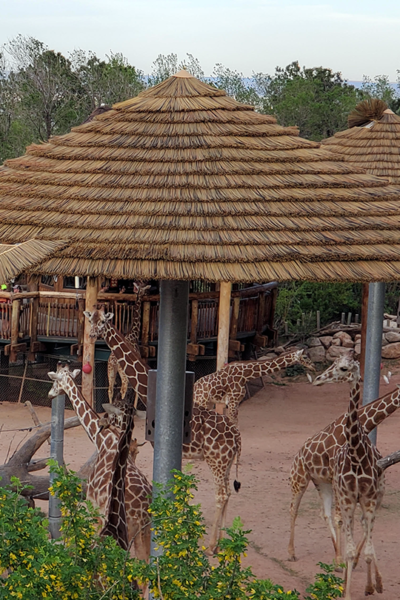

RETICULATED GIRAFFE TO MOVE TO DENVER ZOO IN SUPPORT OF SPECIES SURVIVAL PLAN
BB, a 21-month-old giraffe at Cheyenne Mountain Zoo, will soon be cruising up I-25 to meet her new playmate, 5-year-old Dobby, and his mom, Kipele, at Denver Zoo! Although BB’s exact moving date will not be shared, guests can see her at CMZoo through the Fourth of July holiday weekend.

The move is in support of the Giraffe Species Survival Plan (SSP). SSPs are managed by the Association of Zoos and Aquariums (AZA). They match individual animals throughout AZA-accredited organizations for breeding. The goal is to create the most genetically diverse assurance population of animal ambassadors possible in human care. Zoos accredited by the AZA, including CMZoo and Denver Zoo, regularly participate in animal moves like this for the greater good of the species in our collective care. Although BB won’t immediately participate in the SSP breeding recommendation, this move is a step in that direction. BB’s genetics are valuable to the future diversity of giraffe in human care.
Many people remember BB’s birth at CMZoo in September 2020 to first-time giraffe mom, Bailey. Before the calf received an official name, keepers nicknamed her “BB,” short for “Bailey’s Baby,” and the nickname stuck. Giraffe fans all over the world tuned into her live birth.
Since BB’s personality started to shine, around six months old, keepers have described her as brave and curious. These days, BB is known for pushing through CMZoo’s 16 other, much larger, giraffe to get the best spot for a lettuce snack. Although Denver Zoo plans to give BB quiet time to adjust to her new home, if she shows them she needs it, her care team is confident she’ll adjust to her new life with Dobby and Kipele in no time.
Nearly two years old may seem young to move a giraffe to a new herd, but CMZoo’s and the SSP’s many years of experience have proven that moving smaller giraffe who are no longer dependent on their mothers is ideal. BB has been independent of her mother, Bailey, for a long time.
“We always miss our animals when they move on, but we’re excited to know that BB will be just up the interstate getting excellent care from the team at Denver Zoo,” said Jason Bredahl, African Rift Valley animal care manager. “We know their team well, and have worked with them many times before. They’re committed to the best possible welfare for their animals.”

Dobby, who will be one of BB’s new herd mates, was born at Denver Zoo prematurely, weighing just 73 pounds, in February 2017. Dobby struggled in his first few weeks of life, but his care team’s commitment helped him overcome his early obstacles. In addition to around-the-clock care, Dobby received plasma from the Giraffe Plasma Bank, a program co-led by CMZoo and Columbus Zoo. Mashama and Msitu, two well-known giraffe at CMZoo, donate plasma to help struggling newborn calves, which is often what they need. Four years later, Dobby is thriving at Denver Zoo, and we can’t wait for BB to meet him.
BB is outgoing and energetic – but she’s also extremely intelligent. Her keepers at CMZoo have prepared her for this move, by building trusting relationships and following a customized training program that allows BB to make choices and receive positive reinforcement for participating in training. Building on her foundation of training, BB is preparing for her road trip up north.
“We’ve been introducing BB to new training opportunities, like walking through the trailer loading area by herself, stepping onto the loading ramp, and more,” said Bredahl. “We’ll pack the trailer with her favorite snacks, elm branches, and enriching activities for her short trip and when she’s settling into her new home in Denver.”
Visitors can see BB at CMZoo at least through the Fourth of July holiday weekend. Keep an eye on Denver Zoo’s social media channels for updates and information on when guests can see BB with her new herd, and help us wish BB bon voyage on her big adventure!
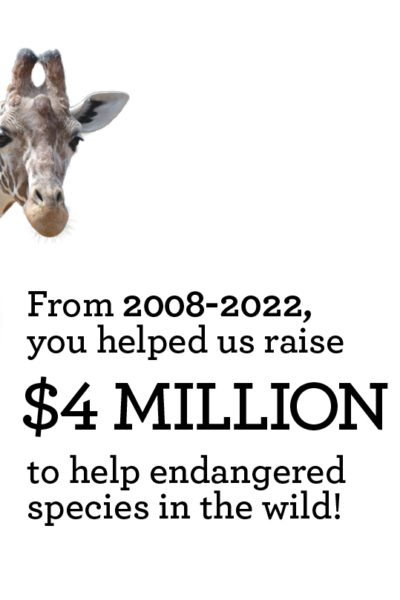


Cheyenne Mountain Zoo and its guests and members are celebrating a huge milestone, having raised $4 million for wildlife and wild places, since the Zoo’s Quarters for Conservation (Q4C) program launched in 2008.
Every visitor to the Zoo receives three “quarter” tokens representing the 75¢ Q4C allocation from their admission fee. They can then show support for the legacy projects they love by placing their tokens in the corresponding slots in the Q4C kiosks.
In recent years, CMZoo staff have traveled to Africa, Central America, Indonesia and the prairies of Wyoming and Colorado, to lend their expertise in support of our partner organizations around the world. Our guests’ support is far-reaching. It benefits the organizations we support, their teams, local communities and the animals they protect. It also enriches the lives of our teammates who return to the Zoo to share new experiences and reignited passions for protecting wildlife and wild places.
Before launching Q4C in 2008, CMZoo was supporting conservation, but at a fraction of what is possible now. As more people visit the Zoo each year, we can contribute more money to conservation. In the past few years, CMZoo has collected about half a million dollars per year through Q4C. In the Zoo’s 2021 fiscal year, guests contributed nearly three-quarters of a million dollars. The Zoo’s membership and EdVenture programs also contribute to conservation. CMZoo’s current beneficiary species include giraffe, Panama frogs, orangutans, black-footed ferrets, African elephants and rhinos, Wyoming toads and African vultures.
About Our Current Q4C Legacy Projects
Q4C beneficiary species truly run the gamut, from 18-foot-tall giraffe in Africa, to tiny toads in Wyoming.

Q4C helps support a multi-organizational giraffe conservation project in Uganda, called Operation Twiga. Operation Twiga began in 2016 to give giraffe a better chance of survival by establishing new populations of giraffe in safe habitats, in partnership with Giraffe Conservation Foundation, Uganda Wildlife Authority and others. Operation Twiga V (2020) was a continuation of Operation Twiga IV (2019), which CMZoo staff attended to assist with anesthesia and moving the giraffe. Both giraffe translocations contributed to populations in Pian Upe Wildlife Reserve, an historic habitat in Uganda where giraffe hadn’t existed for more than 20 years. Ongoing Q4C funding supports the teams who continue to monitor and protect these newly established wild populations.
Q4C also funds CMZoo’s on-site breeding programs for black-footed ferrets and Wyoming toads. These endangered prairie species were declared extinct in the wild in the 1980s and early 1990s, and are only around today because of decades of recovery efforts from zoos and partner organizations. 18 ferret kits were born at CMZoo in the 2021 breeding season, and six juveniles were released into their natural habitat by CMZoo staff and wildlife partners in the fall. In Spring and Summer 2021, CMZoo staff released 228 yearling “headstart” toads, 58 metamorph toadlets, and 5,338 tadpoles to their native habitat in Wyoming. Summer 2022 breed-and-release efforts are well underway, and later this year, more of these vital species will join their relatives in the wild, thanks to CMZoo guests’ support.

Wyoming toads are symbolic of so many amphibian species in decline all over the world, including Panamanian frogs, which also receive support thanks to Q4C funds and frontline CMZoo staff support. In February 2019, three CMZoo staff members went to Panama to assist the Panama Amphibian Rescue and Conservation Project by remodifying two feeder insect pods into frog pods. For this 10-day trip, the goal was to set up two shipping containers to house and breed approximately 450 additional frogs brought in from El Valle Amphibian Conservation Center, and later released. This involved disinfecting the shipping containers, painting, installing plumbing and water filtration, assembling racks, and drilling and prepping tanks.
CMZoo’s work to save habitats for orangutans through advocacy for sustainable palm oil production is also largely supported by Q4C. Thanks to that financial support, CMZoo’s sustainable palm oil team consults staff at other conservation organizations on starting their own palm oil programs. The CMZoo sustainable palm oil team continued to focus on international work through the World Association of Zoos and Aquariums (WAZA). The team was instrumental in the creation of the WAZA Short Guide on Sustainable Palm Oil and the sustainable palm oil shopping app, which allows shoppers to scan the barcodes of items to learn whether producers have committed to using sustainable palm oil.

Through Q4C, CMZoo also supports a conservation partner called Tsavo Trust – an organization in Kenya that works to protect the last of the big tuskers, which are African elephants with tusks weighing more than 100 pounds. CMZoo’s funds helped Tsavo Trust build permanent housing that allowed staff to live on the land where these critically endangered giants live. It also paid for pilot hours of frontline aerial surveillance that protects rhinos and elephants from poachers seeking their ivory.
The seventh Q4C legacy partner is VulPro – protectors of African vultures. The dedicated staff at VulPro, in South Africa, save vultures who have been injured as wild birds, and rehabilitates them to release. Those that are too injured to survive in the wild find a permanent home at VulPro.
For more information about these projects and Quarters for Conservation, visit cmzoo.org/conservation.
About Cheyenne Mountain Zoo
Cheyenne Mountain Zoological Society was founded in 1926. Today, Cheyenne Mountain Zoo, America’s mountain Zoo, offers comprehensive education programs, exciting conservation efforts and truly fantastic animal experiences. In 2021, Cheyenne Mountain Zoo was voted #4 Best Zoo in North America and CMZoo’s Rocky Mountain Wild was named #3 Best Zoo Exhibit in North America by USA TODAY 10Best Readers’ Choice Awards. It is Cheyenne Mountain Zoo’s goal to help guests fall in love with animals and nature, and take action to protect them. Of the 242 zoos and aquariums accredited by the Association of Zoos and Aquariums (AZA), Cheyenne Mountain Zoo is one of just a few operating without tax support. Cheyenne Mountain Zoo depends on admissions, membership dues, special event attendance and donations for funding.
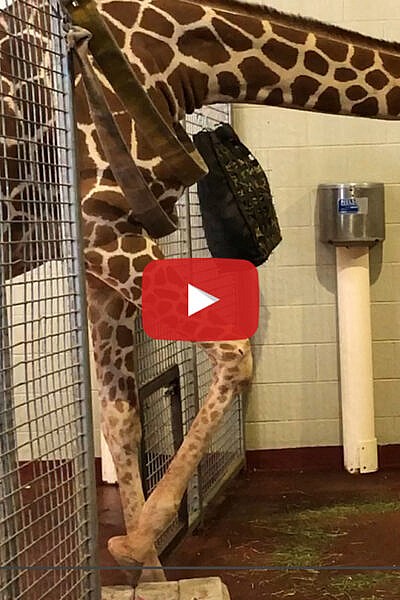

Join our 1-year-old giraffe calf, BB, and her keeper team for two behind-the-scenes training sessions. Our youngest giraffe is working on voluntary husbandry behaviors that allow her team to take the best possible care of her. Watch as BB follows cues and gets positive reinforcement for participating in injection training and voluntary hoof care. Way to go, BB!
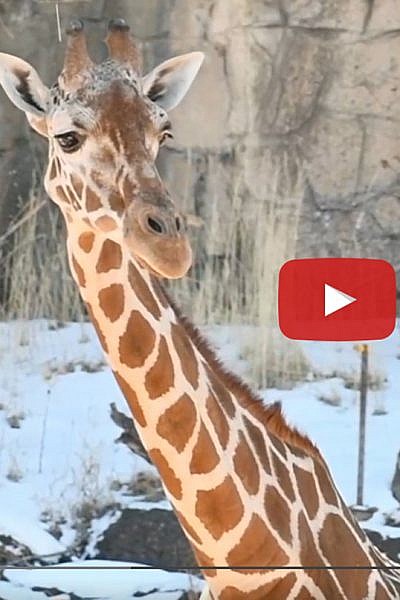

Have you experienced the magic of CMZoo in the winter yet? Some people think there’s less to see and do at the Zoo in the cooler months, but the CMZoo giraffe tower stays busy all year long, regardless of the weather.
Thanks to Colorado’s famous 300 days of sunshine, the 17-member herd explores its outdoor spaces more often than you might think. One member, Ohe, seems to like the additional natural snow ‘enrichment,’ while others get lots of yummy browse and lettuce snacks from guests.
When they’re indoors, keepers get creative with enrichment activities and spend time training the giraffe for husbandry behaviors, like hoof care. Guests can feed the herd from inside their warm barn, too, so there’s no excuse for leaving the Zoo without making a memorable connection with a new tall friend.
We’re open all year, so come and see for yourself! Advance tickets are required: cmzoo.org/visit.
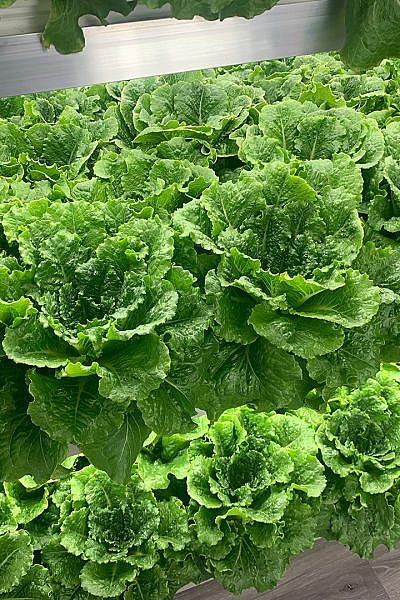


Have you noticed the shipping container next to Cheyenne Mountain Zoo’s historic carousel and wondered what’s going on? CMZoo is planning to grow lettuce using a retired shipping container. But, that’s simplifying things. Inside the modified shipping container’s sturdy walls lies a high-tech, energy efficient, and bio-safe grow house.
It’s hard to find a project much greener than this. The new grow house is energy-, water- and space-efficient. Because the grow pod’s shell was a freezer shipping container in its previous life, it’s heavily insulated. That will protect the plants from Colorado’s extreme temperature ranges.
The hydroponic lettuce growing system inside the container is one of the most efficient ways to grow lettuce – and anyone who has visited our 17-member giraffe herd knows we go through a lot of lettuce.
“It fluctuates throughout the year, but on average, we use more than 3,500 heads of romaine lettuce per month,” said Alex Crochet, CMZoo horticulture curator. “It’s just a small part of the giraffes’ diet, but it’s a huge part of our guests’ experience. The goal is to grow about 55% of the Zoo’s lettuce using grow pods like this one, if this test is successful.”
Crochet’s excitement for this project is contagious, and his hope is to inspire gardeners who visit the Zoo.

“It’s a whole new adventure for our horticulture team, and we’re really excited about all we’re going to learn,” said Crochet. “Eventually, we hope to have our grow pod set up in a way that our guests can learn more about sustainable farming, too. As residents of a drought state, we Coloradans can take advantage of technologies like these to save water and still grow our own produce.”
The single grow pod should produce about an acre’s worth of lettuce using only 40 gallons per day. The system also uses a dehumidifier to capture excess water from the air and filter it back into the watering reservoirs. The ebb-and-flow hydroponic system uses less than a typical shower to fuel hundreds of heads of lettuce, which Crochet hopes to plant and harvest on a schedule that produces delicious fresh lettuce on a weekly basis – eventually.
The test pod is now connected to electricity, and next, it will be hooked up to a water supply. After that, the team will get started on planting. Swing by and take a peek through the glass doors of the container to see the progress for yourself.
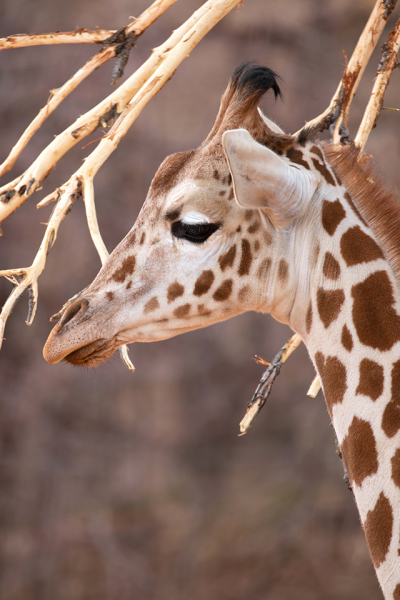


Our ‘firecracker,’ Viv, is turning two years old! Born two days after the Fourth of July, on July 6, 2019, Msitu and Khalid’s daughter gained her nickname pretty much immediately and has lived up to it ever since. Just six hours after she was born, Viv famously leap-frogged over Msitu’s back (while she was lying down), gaining an adorable reputation as independent, strong and super-charged.
Our partner, Children’s Hospital Colorado, is also celebrating the ‘terrific twos!’ They opened southern Colorado’s first pediatric-only hospital, right here in Colorado Springs, on July 17, 2019. To celebrate, Children’s Hospital Colorado is throwing our ever-vivacious Viv a birthday party – and you’re invited. Join us for a belated birthday on Sat., July 17, 2021, from 10 a.m. to noon in African Rift Valley for Viv’s second birthday party, complete with a ‘birthday cake’ for Viv, served at 11:15 a.m. The celebration will include opportunities for Viv’s fans to write her a birthday card, sing her happy birthday and visit our 17-member herd of giraffe.
“Knowing our Viv, she’ll continue to keep us on our toes as she has from day one,” said Amy Schilz, senior lead keeper in African Rift Valley, and Viv’s primary trainer. “This girl has become known for her adorable antics, like running after the cranes and guinea fowl in the yard, or stretching to reach a tree we didn’t intend to be giraffe food. Pretty much any time we get a radio call that one of the giraffe is up to something, we know it’s probably Viv!”

Viv seemed to surpass giraffe calf milestones with ease, but her independence meant that she seemed to prefer to be alone more than other giraffe, too. That has all changed since 2-year-old Ohe, 9-month-old BB and 3-year-old Panya joined the herd. Viv’s keepers say she seems to have come out of her shell with guests and the herd, since her three ‘besties’ have boosted her confidence.
“She has become really outgoing since becoming part of the four ‘littles’ group,” said Schilz. “You can usually find Viv and Ohe together. They get each other going in the yard, and will kick up the dirt and encourage each other to run around. We’ve also seen them ‘cuddling,’ when they take naps and lie down right next to each other in the barn mid-day. Because they seem to really like to be together, we have ‘baby training days,’ in the barn.”

To perform the important hoof care work that is vital the giraffe’s overall health, keepers train the giraffe to voluntarily participate. Through positive reinforcement training, the giraffe learn to approach a hoof care block, place one foot on the block and keep it there while their trainers trim their hooves. Viv has mastered the approach and placement, but has other plans about what happens next. Each time a giraffe completes a successful step in the training, they get a reward. Smart and sassy Viv is well aware.
“Sometimes she outsmarts me in those training sessions,” said Schilz. “She’s learned if she touches her hoof to the block and then takes it off and puts it on again, she gets more treats. So now I’m having to go back in my training and figure out a new way to move forward. It’s been a really great team bonding experience, because we all share what works for her unique needs. We tailor training to each giraffe, and she is certainly pushing us and challenging us to stay flexible. We’ll get there.”
Please join us in wishing Viv a very happy second birthday, and in thanking our friends at Children’s Hospital Colorado for their partnership!
Viv’s 2nd Birthday Party
In Partnership with Children’s Hospital Colorado
All are invited; Zoo admission is required
Saturday, July 17, 2021
African Rift Valley
10 a.m to noon
11:15 a.m. ‘birthday cake’ for Viv